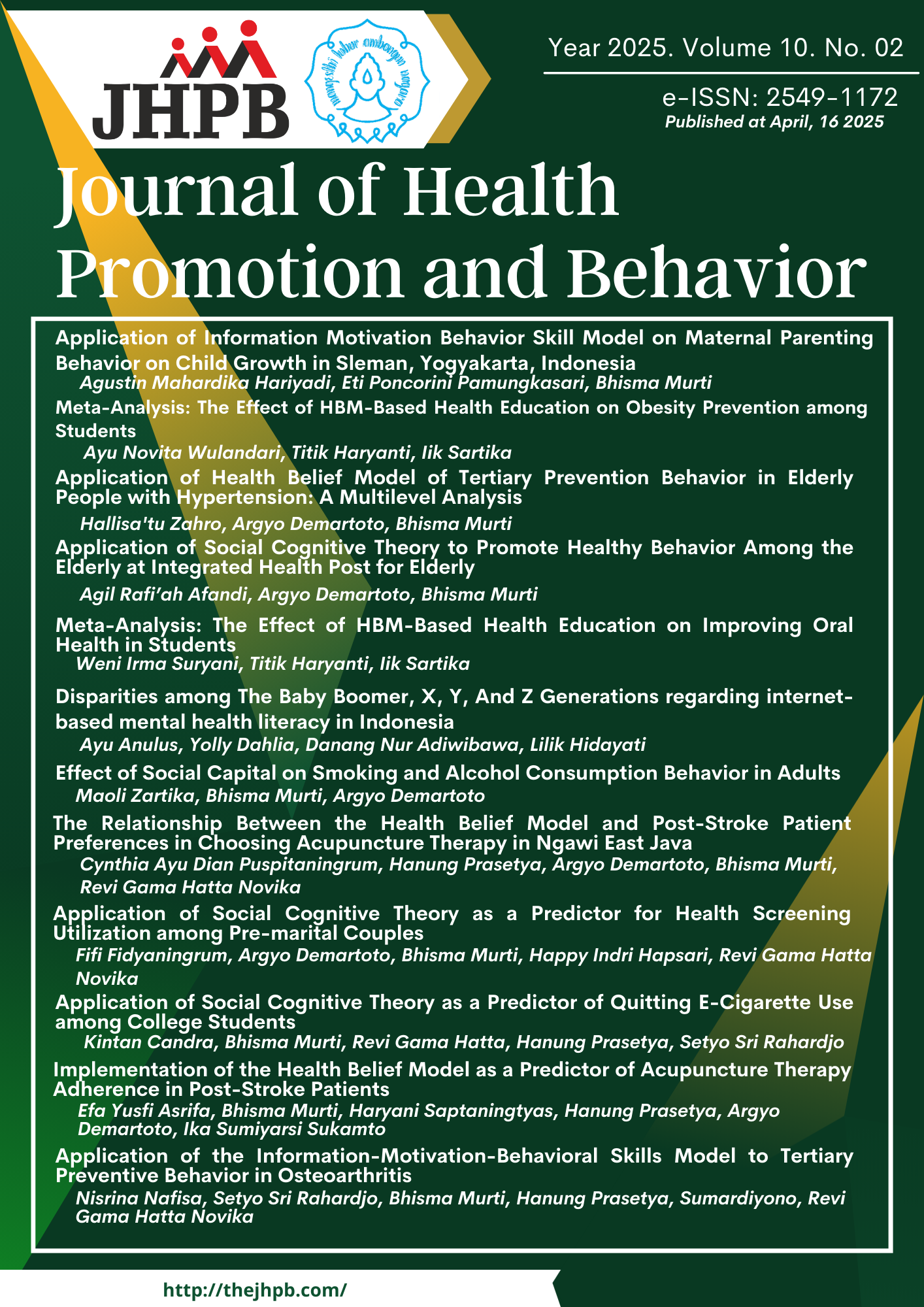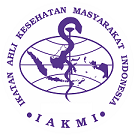Relationships Between the Health Belief Model Constructs and Post-Stroke Patient Preferences in Choosing Acupuncture Therapy in Ngawi East Java
DOI:
https://doi.org/10.26911/thejhpb.2025.10.02.08Abstract
Background: Stroke is a serious medical condition that poses a significant risk of mortality and long-term disability, making it one of the leading causes of death and disability worldwide. Selecting an appropriate therapy is crucial to enhancing the quality of life among post-stroke patients. The Health Belief Model (HBM), which emphasizes individual beliefs regarding health and illness, is thought to play a pivotal role in influencing patients' decisions when choosing therapeutic interventions. This study aims to analyze the application of the Health Belief Model in the selection of acupuncture therapy among post-stroke patients.
Subjects and Method: This study employed a cross-sectional design and was conducted in Ngawi Regency from October to December 2024. 200 samples of post-stroke patients were taken using the fixed disease sampling technique, consisting of 100 patients undergoing acupuncture and 100 patients undergoing physiotherapy. Dependent variables were the preference of acupuncture therapy and physiotherapy. Independent variables were perceived severity, perceived benefits, perceived barriers, cues to action, and self-efficacy. Data was collected using questionnaires and analyzed using path analysis on STATA 17.
Results: The preference for acupuncture therapy was directly influenced by self-efficacy (b=3.41; CI95%=2.59 to 4.23; p<0.001). Self-efficacy to undergo acupuncture therapy was influenced by the perceived benefits (=2.75; CI95%=1.74 to 3.75; p<0.001), perceived barrier (b=-0.94; CI95%=-1.96 to 0.80; p<0.001), and cues to action (b=3.36; CI95%=2.32 to 4.40; p<0.001). Perceived benefit was influenced by perceived severity (b=1.25; CI95%=0.62 to 1.88; p<0.001).
Conclusion: Self-efficacy directly influences the preference for acupuncture therapy. Meanwhile, the perceived benefit, the perceived barrier, and cues of action indirectly affect the preference for acupuncture therapy through self-efficacy. Perceived benefit was influenced by severity perception.
Keywords:
Health Belief Model, Acupuncture , Rehabilitation, StrokeHow to Cite
References
Alhofaian A, Alaamri MM, Abdalmajeed MA, Wadaah LS, Aljuhani LA, Amin MA, Alharazi R (2024). The Role of Illness Perception and Self Efficacy in Determining Quality of Life Cancer Patients. Clin Pract, 14(2), 498–507. doi.org/10.3390/clinpract14020038
Alyafei A, Easton-Carr R (2024). The Health Belief Model of Behavior Change. In: StatPearls [Internet]. Treasure Island (FL): StatPearls Publishing; 2024 Jan-. PMID:3916-3427.
Ariyanti KS, Sariyani MD, Pemayun CIM (2020). Kepercayaan Masyarakat Terhadap Pengobatan Komplementer Akupuntur Di Praktik Perawat Man-diri Latu Usadha Abiansemal Badung. Jurnal Ilm Kes MAKIA, 10(2), 107–116. doi.org/10.37413/jmakia.v10i2.14
Asfy I, Primanita RY (2024). Gambaran Health Belief Model Pada Pasien Stroke Di Pengobatan Tradisional Us-tad X. CAUSALITA : J Psych, 1(4), 123–131. https://doi.org/10.62260/-causalita.v1i4.139
Balitbangkes (2018). Laporan Riskesdas 2018 Nasional. Lembaga Penerbit Balitbangkes. Retrieved from reposi-tory.badankebijakan.kemkes.go.id/ LaporanRiskesdas 2018 Nasional
Bao T, Li Q, DeRito JL, Seluzicki C, Im EO, Mao J (2018). Barriers to Acupun-cture Use Among Breast Cancer Sur-vivors: A Cross-Sect Analysis. Intgrtve Cancer Thrps 17(3), 854–859. Doi-.org/10.1177/1534735418754309
Bishop FL, Lewith GT (2013). Patients’ preconceptions of acupuncture: A qualitative study exploring the deci-sions patients make when seeking acupuncture. BMC Compl and Altrntve Med, 13. doi.org/10.1186/14-72-6882-13-102
Cao HJ, Li X, Li XL, Ward L, Xie ZG, Hu H, Liu JP (2020). Factors influencing participant compliance in acu uncture trials: An in-depth interview study. PLoS ONE, 15(4), 1–12. doi.org/10.13-71/journal.pone.0231780
Chavez LM, Huang SS, MacDonald I, Lin JG, Lee YC, Chen YH (2017). Mecha-nisms of acupuncture therapy in ischemic stroke rehabilitation: A literature review of basic studies. Int J Mol Sciences, 18(11), 1–14. doi: 10.3390/ijms18112270
Chohan SA, Venkatesh PK, How CH (2019). Long-term complications of stroke and secondary prevention: An overview for primary care physicians. Singapore Med J, 60(12), 616–620. https://doi.org/10.11622/smedj.2019158
Dinas Kesehatan Jawa Timur (2023). Profil Kesehatan Provinsi Jawa Timur Tahun 2022.
Gurmu Y (2022). Patient Preferences in Shared Decision Making During Healthcare and Associated Factors Among Adult Admitted Patients at Public Hospitals of West Shoa Oromia, Ethiopia. Patient Pref Adh, 16: 1781–1786. https://doi.org/1-0.2147/PPA.S376600
Handayani P (2017). Teknik Pengukuran (Human Factor Test and Evaluation) MODUL 4 Health Belief Model. Human Error Theory - Health Belief Model, 4(2), 1–15.
Hopton A, Thomas K, MacPherson H (2013). The Acceptability of Acupunc-ture for Low Back Pain: A Qualitative Study of Patient’s Experiences Nested within a Randomised Controlled Trial. PLoS ONE, 8(2). doi.org/10. 1371/jour-nal.pone.0056806
Indonesian Ministry of Health (2013). National Basic Health Report Year 2013.
Khazaeian S, Khazaeian S, Fathnezhad KA (2020). Pregnant Women’s Know-ledge, Perceived Severity, and Per-ceived Controllability of The COvid-19 and Their Associations With Emo-tional and Behavioral Reactions: A Cross-Sectional Study. R Square, 1–21. http://dx.doi.org/10.21203/rs.3 .rs-132425/v1
Klompstra L, Jaarsma T, Strömberg A (2018). Self-efficacy Mediates the Relationship between Motivation and Physical Activity in Patients with Heart Failure. J Cardiovasc Nurs. 33(3): 211–216. doi.org/10.1097/JCN-.0000000456
Krist AH, Tong ST, Aycock RA, Longo DR (2017). Engaging patients in decision-making and behavior change to promote prevention. Stud Health Tech Inform 240: 284–302. https://-doi.org/10.3233/978-1-6149 9-790-0-284
Li S (2023). Stroke Recovery Is a Journey: Prediction & Potentials of Motor Recovery after a Stroke from Practical Perspective. Life, 13(10), 1–13. Do-i.org/10.3390/life13102061
Liu B, Xu H, Guo S, Wu J, Liu J, Lim MY, Liu Z (2013). Prevalence and corre-lates of discomfort and acce ptability of acupuncture among outpatients in chinese acupuncture and moxibustion departments: A cross-sectional study. Evid Based Complement Alternat Med. 2013:715480 https://doi.org/-10.1155/ 2013/ 715480
Liu W, Towell-Barnard A, Lee KH, Leen Kang T (2024). Participants expe rien-ces regarding the use of acu puncture as a treatment modality: A qualitative systematic review. Complement Ther Clin Pract. 57: 101866. https://doi.-org/10.1016/j.ctcp.2024.101866.
Pinto J, Bradbury K, Newell D, Bishop FL (2022). Lifestyle and health behaviour change support in traditional acupun-cture: a mixed method survey study of reported practice (UK). BMC Comple ment Med Ther. 22(1), 1–12. Do i.org/ 10.1186/s12906-022-03719-6
Prasetya H, Murti B, Anantanyu S, Syam-sulhadi M (2018). The Effect of Hyp-nosis on Adherence to Anti tuber-culosis Drugs Using the Health Belief Model. Int J Clin Exp Hypn. 66(2): 211–227. Https://doi.org/10. 1080/0-0207144.2018.1421361
President of Indonesia (2023). Undang-Undang Republik Indonesia Nomor 17 Tahun 2023 Tentang Kesehatan. Undang-Undang, (187315), 1–300.
Purwanto, Dharmawan R, Demartoto A (2016). Decision to choose acupunc-ture therapy for degenerative diseases among the el derly at Ja’far Medika Hospital, Karanganyar. J Health Promot Be hav. 01(02), 127–137. doi: 10.26 911/thejhpb.2016. 01.-02.08
Putri RM, Devi HM, Parnawati TA (2024). Perceived barriers as primary deter-minant factor in uncleanliness and unhealthy behavior among ado les-cents. Care : J Ilmiah Ilmu Kes, 12(2), 260–268. doi.org/10.3336 6/jc.v12i2.-4709.
Rabinstein AA, Shulman LM (2003). Acu-puncture in clinical Neurology. Neurologist. 9(3):137-48. doi: 10.10-97/00127893-200305000-00002.
Rahmawati RN, Lahdji A, Anggraini MT (2024). The Relationship of Perceived Severity and Recurrent Stroke Pre-vention Behavior at Post-Non-Hemor rhagic Stroke Patients. South East Asia Nurs Resrch, 6(1), 25. doi.org/ 10.26714/seanr.6.1.2024.25-31
Rosenstock IM., Strecher VJ, Becker MH (1994). The Health Belief Model and HIV Risk Behavior Change, 5–24. doi.org/10.1007/978-1-4899-1193-3_2
Rugg S, Paterson C, Britten N, Bridges J, Griffiths P (2011). Traditional acu-puncture for people with medically unexplained symptoms: A longi-tudinal qualitative study of patients’ experiences. British J of Gen Prctce. 61(587), 306–315. https://doi.or g/10-.3399/bjgp11X577972
Shahid J, Kashif A, Shahid MK (2023). A Comprehensive Review of Physical Therapy Interventions for Stroke Rehabilitation: Impairment-Based Approaches and Functional Goals. Brain Sci, 13(5). doi: 10.339 0/brain-sci13050717.
Törnblom M, Hansson EE (2022). Corre-lation between self-efficacy, fear of movement, empowerment, ena ble-ment, and number of visits to physio-therapist among patients with musculoskeletal disorders in primary health care: a feasibility study. Pilot Feasibility Stud, 8(1), 1–9. https://-doi.org/10.1186/s40814-022-01101-4
Vancouver JB, Kendall LN (2006). When self-efficacy negatively relates to moti vation and performance in a learning context. J App Psych. 91(5): 1146–1153. doi.org/10.103 7/0021-9010.91. 5.1146.
Wang H, Jia J, Fan Y, Chen H, Lou Y, Wang X, Huang X (2024). Impact of inpatient self-efficacy and trust in physicians on inpatient satisfaction with medical services: the mediating role of patient participation in medical decision-making. Front Psy. 15: 1–12. doi.org/10.33 89/fpsyg.20 24.1364319.
World Stroke Organization (WSO) (2022). Global Stroke Fact Sheet 2022 Purpose : Data sources : World Stroke Organization (WSO).
World Health Organization (2019). Stroke. New Delhi: All India Institute of Medical Sciences (AIIMS).
WHO (2024). Stroke, Cerebrovascular acci-dent. Retrieved September 15, 2024, from https://www.emro.w ho.int/-health-topics/stroke-cerebrovascular accident
Wijayanti RA, Sa’adah HD, Komalawati R (2024). Pengaruh Health Education terhadap Pengetahuan dan Keteram-pilan Keluarga tentang Range Of Motion pada Pasien Stroke Keluar Rumah Sakit di Ruang Tulip RSUD dr. Soeroto Ngawi. Cakra Med 11(1), 95–103.
World Health Organization (2019). Stroke. New Delhi: All India Institute of Medical Sciences (AIIMS).
Wu SW, Chiang PY (2023). Exploring the Moderating Effect of Positive and Negative Word-of-Mouth on the Relationship between Health Belief Model and the Willingness to Receive COVID-19 Vaccine. Vaccines, 11(6). doi.org/10.3390/vaccines11061027
Yam W, Wilkinson JM (2010). Is acu punc-ture an acceptable option in stroke rehabilitation? A survey of stroke patients. Complement Ther Med. 18 (3–4): 143–149. https://doi.or g/ 10.-1016/j.ctim.2010.05.033.





